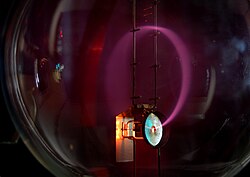Discovery made on this thread by dyetalon
Dear dyetalon,
Thank you for the history review of Trintron (aperture grille) Sony CRT technolgy back from the 90's, you brought me back many memories during my Electronic Engineering studies. I repaired actually quite many of sony trinitrons back at these days...

You really nailed it down my friend Bravo! And made clear a difference of the ferrocell from a crt!!
The reason why ferrocell shows the same image of a magnetic field when the magnet N-S axis is placed parallel to the glass surface in whatever azimuth but a crt screen does NOT IS:
In the ferrocell the nanoparticles and ferrofluid are not directionally confined and are free to move to any direction they directed by the induced magnetic field. As you have already described in your Ferrocell official site,
You are right the nanoparticles have 6 degrees of freedom (6DoF) of motion achieving therefore the most high fidelity and reliable image imprint of a magnetic field there is by any other imaging technology.
Coming now to the crt's, we can clearly see in the pictures you provided below,
(advise, just go to advanced editing mode in the forum, attach the image files you like and then use the provided link to insert the images with the [IMG][IMg] function)


that the phosphorous in the CRT is physically confined or trapped in vertical stripes at the Y direction without any freedom to move at the X direction of the screen whereas in the ferrocell the ferrofluid can freely move on the XY plane and even the Z plane in a reduced degree however i must say. That is exactly the reason why whenever you place the N-S axis of a magnet parallel to the CRT stripes you get correct imaging of the magnetic field but whenever you place the N-S axis perpendicular to the stripes you get actually a distorted image of the field! In order to analyse the resulting distorted magnetic image by the crt you see in the second case you need a detailed optical analysis which is not really in our scope now.
So thank you again for explaining this important difference on magnetic field imaging between crt and ferrocell, thus crt - ferrocell = 0 - 1
your friend,
EM
Originally posted by dyetalon
View Post
Thank you for the history review of Trintron (aperture grille) Sony CRT technolgy back from the 90's, you brought me back many memories during my Electronic Engineering studies. I repaired actually quite many of sony trinitrons back at these days...


You really nailed it down my friend Bravo! And made clear a difference of the ferrocell from a crt!!
The reason why ferrocell shows the same image of a magnetic field when the magnet N-S axis is placed parallel to the glass surface in whatever azimuth but a crt screen does NOT IS:
In the ferrocell the nanoparticles and ferrofluid are not directionally confined and are free to move to any direction they directed by the induced magnetic field. As you have already described in your Ferrocell official site,
A Ferrocell responds to an induced magnetic field and is capable of scattering light with more
degrees of freedom than either MEMS* or FLCD** technology can obtain.
degrees of freedom than either MEMS* or FLCD** technology can obtain.
Coming now to the crt's, we can clearly see in the pictures you provided below,
(advise, just go to advanced editing mode in the forum, attach the image files you like and then use the provided link to insert the images with the [IMG][IMg] function)
that the phosphorous in the CRT is physically confined or trapped in vertical stripes at the Y direction without any freedom to move at the X direction of the screen whereas in the ferrocell the ferrofluid can freely move on the XY plane and even the Z plane in a reduced degree however i must say. That is exactly the reason why whenever you place the N-S axis of a magnet parallel to the CRT stripes you get correct imaging of the magnetic field but whenever you place the N-S axis perpendicular to the stripes you get actually a distorted image of the field! In order to analyse the resulting distorted magnetic image by the crt you see in the second case you need a detailed optical analysis which is not really in our scope now.
So thank you again for explaining this important difference on magnetic field imaging between crt and ferrocell, thus crt - ferrocell = 0 - 1

your friend,
EM

 ) therefore total light absorbtion thus the blackness.
) therefore total light absorbtion thus the blackness.








Comment